Rasam is a tangy, spiced, herby and soupy preparations from the South Indian cuisine. Rasam is a staple in many South Indian households and has a base of various herbs, spices, lentils, veggies/fruits and tamarind. My quick Rasam recipe is made without rasam powder and lentils (dal). This spiced, tangy, and sour rasam is sure to warm your palate and heal your cold if you have any.
About Rasam Recipe :
Rasam is a staple South Indian soup-like dish made with tamarind, spices, herbs, and veggies or fruits. Yes, you heard me right – rasam is made with some fruits too.
Probably the word “rasam” is derived from the word “ras” or “rasa” which means juice or extract or essence.
Rasam recipe is a basic simple South Indian rasam that can be had as a drink or served with rice. You do not need any Rasam Powder to make it nor you have to spend time cooking lentils.
Bisi Bele Bath Recipe (Karnataka Style) :Read Here
This rasam recipe happens to be a family favorite and I make it similar to my Tomato Rasam recipe. The main difference between a tomato rasam and a classic rasam is the amount of tomatoes.
Obviously, in a tomato rasam, more tomatoes are added. But in a basic rasam, just one tomato is enough or you can skip it completely. The sour taste in a classic South Indian rasam recipe comes mainly from using tamarind and not tomatoes.
Though rasam is good to soothe a cold or cough you can still make it in any season. I make it pretty often, especially in the winters.
The spices and herbs that I add to my rasam recipe are cumin, mustard seeds, black pepper, garlic, curry leaves, coriander leaves, and tamarind that help in relieving the cold and also act as digestives. It is best to have it in chilly winters or when you are suffering from cough and cold.
Rasam can be had like a soup or as an appetizer drink. It can also be served with steamed rice along with a side vegetable dish and with sambar. You can also have idli or vada with rasam.
Simple Steps on to recover deleted files by Mcafee antivirus by Mistake
How to make Rasam Recipe
I have explained the making of the recipe in three parts. The first part includes making the tamarind water, the second part shows grinding the spices, and the third part details the method of making rasam.
Make Tamarind Water
- Soak 1 lemon sized tamarind (approx 1 tablespoon tightly packed seedless tamarind) in ½ cup warm water for 20 to 30 mins.
:max_bytes(150000):strip_icc()/GettyImages-1147545054-2000-cf62d6b8188846518193157fba8449be.jpg)
- Later squeeze the soaked tamarind to a pulp. Strain and keep aside. In the below photo, the tamarind pulp is not strained.
Grind Spices
- In a dry grinder or coffee grinder, ground 3 teaspoon cumin seeds, 2 teaspoon whole black pepper, and 6 to 7 roughly chopped garlic (medium-sized) to a semi-fine consistency.
Make Rasam
- Heat 2 tablespoons of oil and add 1 teaspoon mustard seeds. When the mustard seeds splutter, add two pinches of asafoetida, 2 to 3 dry red chilies, and 10 to 12 curry leaves. Be careful not to burn the spices.
- Add ½ cup chopped tomatoes. Sauté until the tomatoes soften.
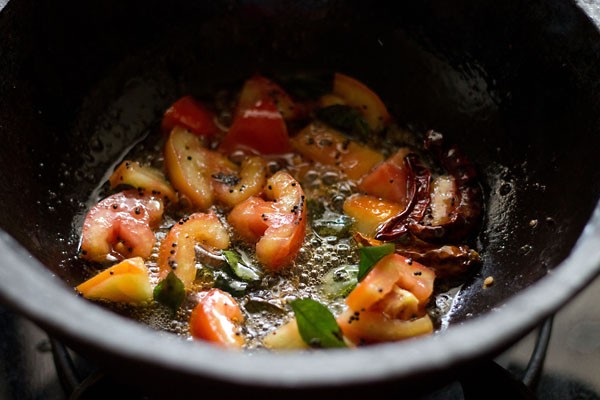
- Then add the semi-coarsely ground cumin seeds, black pepper and garlic, and ½ teaspoon turmeric powder.
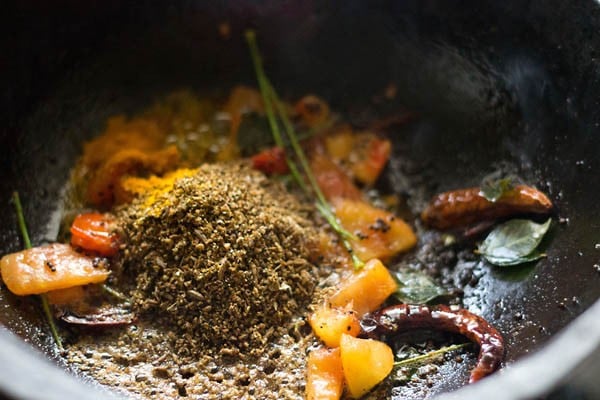
- Mix well and add the strained tamarind pulp along with water and salt.
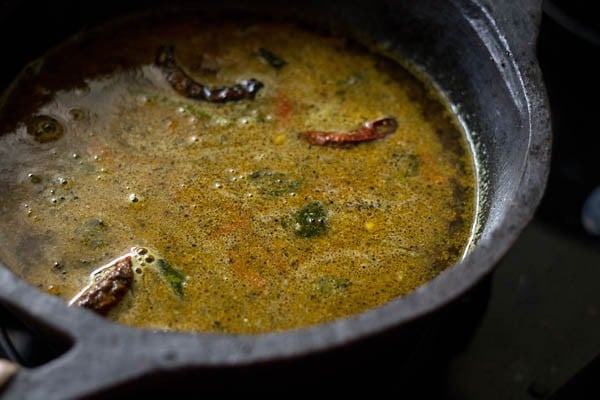
- Let it come to a gentle simmer on a low heat. Do not boil, but let it slowly come to a point of gentle boil and then switch off the heat.
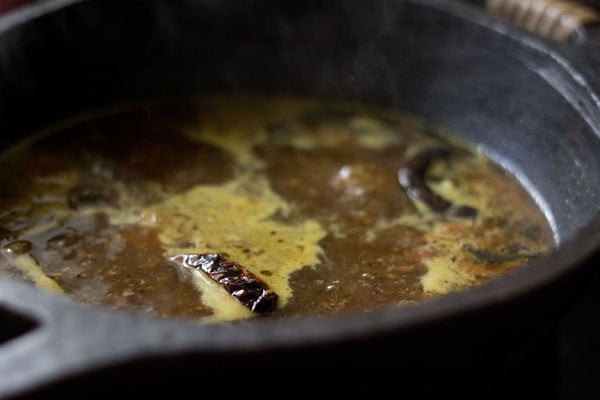
- Turn off the heat and add 2 to 3 tablespoons of chopped coriander leaves.
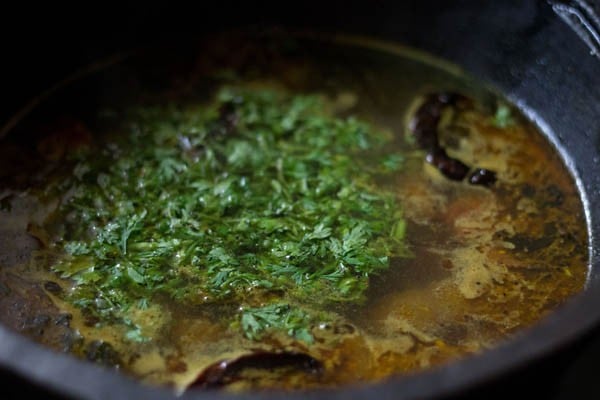
- Stir and serve rasam hot with steamed rice or as a soup.
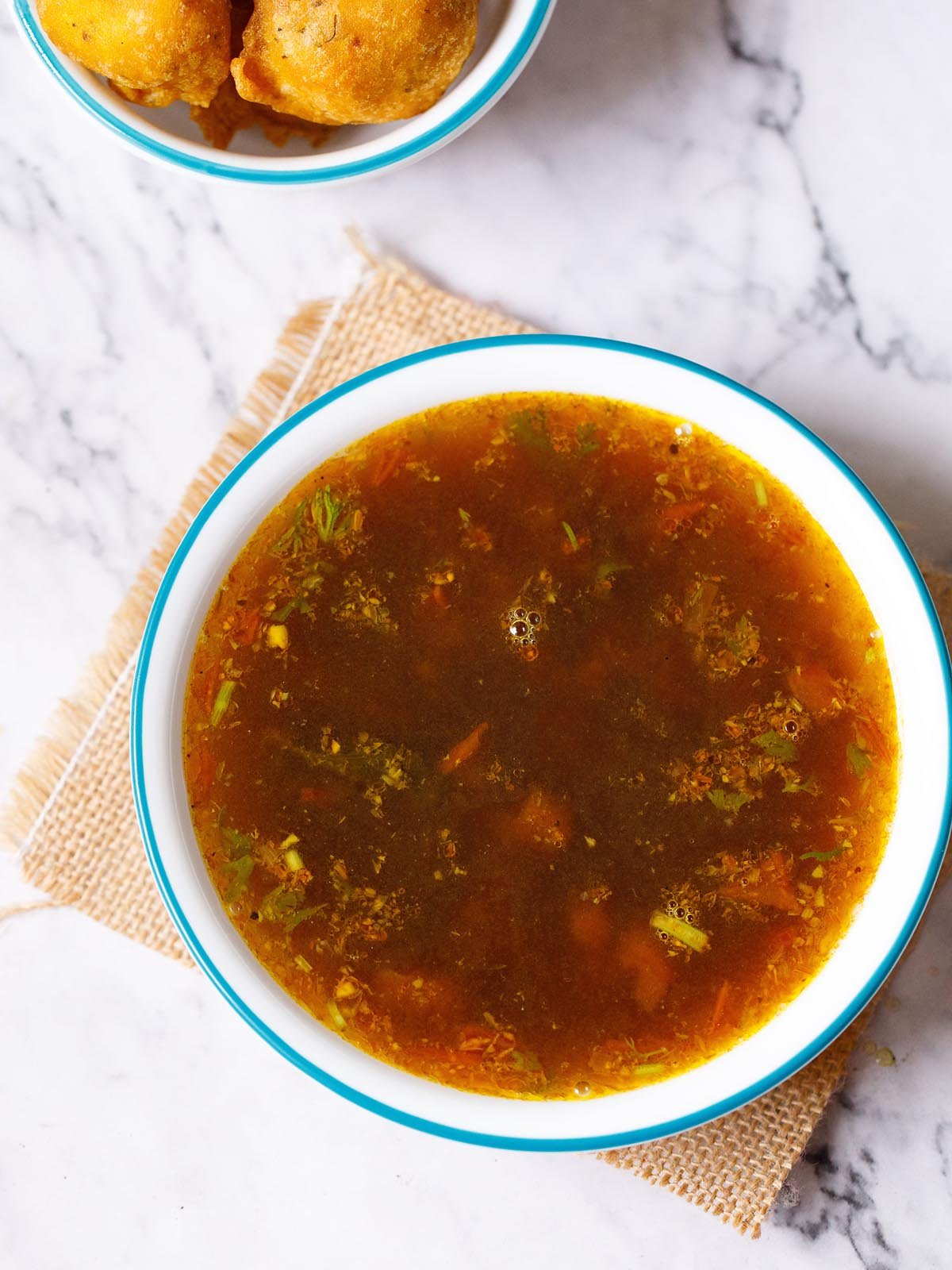
Serving Suggestions
The consistency of rasam is thin like a runny soup or stock. So you can drink it like soup. In South Indian meals, it is served with steamed rice, sambar, and a side vegetable dish.
You can also serve it with just plain steamed rice. I usually make it with rice and pair it with a side vegetable dish.
Kannada
ರಸಂ ರೆಸಿಪಿ (ರಸಂ ಪೌಡರ್ ಮತ್ತು ಲೆಂಟಿಲ್ ಇಲ್ಲದೆ)
ರಸಂ ದಕ್ಷಿಣ ಭಾರತೀಯ ಪಾಕಪದ್ಧತಿಯಿಂದ ಕಟುವಾದ, ಮಸಾಲೆಯುಕ್ತ, ಗಿಡಮೂಲಿಕೆ ಮತ್ತು ಸೂಪಿ ಸಿದ್ಧತೆಯಾಗಿದೆ. ಅನೇಕ ದಕ್ಷಿಣ ಭಾರತದ ಮನೆಗಳಲ್ಲಿ ರಸಂ ಪ್ರಧಾನವಾಗಿದೆ ಮತ್ತು ವಿವಿಧ ಗಿಡಮೂಲಿಕೆಗಳು, ಮಸಾಲೆಗಳು, ಮಸೂರಗಳು, ತರಕಾರಿಗಳು/ಹಣ್ಣುಗಳು ಮತ್ತು ಹುಣಸೆಹಣ್ಣುಗಳ ಮೂಲವನ್ನು ಹೊಂದಿದೆ. ನನ್ನ ತ್ವರಿತ ರಸಂ ಪಾಕವಿಧಾನವನ್ನು ರಸಂ ಪುಡಿ ಮತ್ತು ಮಸೂರ (ದಾಲ್) ಇಲ್ಲದೆ ತಯಾರಿಸಲಾಗುತ್ತದೆ. ಈ ಮಸಾಲೆಯುಕ್ತ, ಕಟುವಾದ ಮತ್ತು ಹುಳಿ ರಸಂ ನಿಮ್ಮ ಅಂಗುಳನ್ನು ಬೆಚ್ಚಗಾಗಿಸುವುದು ಮತ್ತು ನಿಮ್ಮಲ್ಲಿ ಯಾವುದಾದರೂ ಇದ್ದರೆ ನಿಮ್ಮ ಶೀತವನ್ನು ಗುಣಪಡಿಸುವುದು ಖಚಿತ.
ರಸಂ ರೆಸಿಪಿ ಬಗ್ಗೆ
ರಸಂ ಎಂಬುದು ಹುಣಸೆಹಣ್ಣು, ಮಸಾಲೆಗಳು, ಗಿಡಮೂಲಿಕೆಗಳು ಮತ್ತು ತರಕಾರಿಗಳು ಅಥವಾ ಹಣ್ಣುಗಳೊಂದಿಗೆ ತಯಾರಿಸಲಾದ ದಕ್ಷಿಣ ಭಾರತೀಯ ಸೂಪ್ ತರಹದ ಭಕ್ಷ್ಯವಾಗಿದೆ. ಹೌದು, ನೀವು ಹೇಳಿದ್ದು ಸರಿಯಾಗಿಯೇ ಇದೆ – ರಸಂ ಅನ್ನು ಕೆಲವು ಹಣ್ಣುಗಳಿಂದಲೂ ತಯಾರಿಸಲಾಗುತ್ತದೆ.
ಬಹುಶಃ “ರಸಂ” ಪದವು “ರಸ್” ಅಥವಾ “ರಸ” ಎಂಬ ಪದದಿಂದ ಬಂದಿದೆ, ಇದರರ್ಥ ರಸ ಅಥವಾ ಸಾರ ಅಥವಾ ಸಾರ.
ನನ್ನ ರಸಂ ಪಾಕವಿಧಾನವು ಒಂದು ಮೂಲಭೂತ ಸರಳವಾದ ದಕ್ಷಿಣ ಭಾರತೀಯ ರಸಂ ಆಗಿದ್ದು ಅದನ್ನು ಪಾನೀಯವಾಗಿ ಸೇವಿಸಬಹುದು ಅಥವಾ ಅನ್ನದೊಂದಿಗೆ ಬಡಿಸಬಹುದು. ಇದನ್ನು ತಯಾರಿಸಲು ನಿಮಗೆ ಯಾವುದೇ ರಸಂ ಪೌಡರ್ ಅಗತ್ಯವಿಲ್ಲ ಅಥವಾ ನೀವು ಬೇಳೆ ಬೇಯಿಸಲು ಸಮಯ ಕಳೆಯಬೇಕಾಗಿಲ್ಲ.
ಈ ರಸಂ ರೆಸಿಪಿ ಕುಟುಂಬದ ಅಚ್ಚುಮೆಚ್ಚಿನದಾಗಿದೆ ಮತ್ತು ನಾನು ಇದನ್ನು ನನ್ನ ಟೊಮೆಟೊ ರಸಂ ರೆಸಿಪಿಯಂತೆಯೇ ಮಾಡುತ್ತೇನೆ. ಟೊಮೆಟೊ ರಸಂ ಮತ್ತು ಕ್ಲಾಸಿಕ್ ರಸಂ ನಡುವಿನ ಪ್ರಮುಖ ವ್ಯತ್ಯಾಸವೆಂದರೆ ಟೊಮೆಟೊಗಳ ಪ್ರಮಾಣ.
ನಿಸ್ಸಂಶಯವಾಗಿ, ಟೊಮೆಟೊ ರಸದಲ್ಲಿ, ಹೆಚ್ಚು ಟೊಮೆಟೊಗಳನ್ನು ಸೇರಿಸಲಾಗುತ್ತದೆ. ಆದರೆ ಮೂಲ ರಸಂನಲ್ಲಿ, ಕೇವಲ ಒಂದು ಟೊಮೆಟೊ ಸಾಕು ಅಥವಾ ನೀವು ಅದನ್ನು ಸಂಪೂರ್ಣವಾಗಿ ಬಿಟ್ಟುಬಿಡಬಹುದು. ಕ್ಲಾಸಿಕ್ ಸೌತ್ ಇಂಡಿಯನ್ ರಸಂ ರೆಸಿಪಿಯಲ್ಲಿ ಹುಳಿ ರುಚಿ ಮುಖ್ಯವಾಗಿ ಹುಣಸೆಹಣ್ಣನ್ನು ಬಳಸುವುದರಿಂದ ಬರುತ್ತದೆ ಮತ್ತು ಟೊಮೆಟೊಗಳಿಂದಲ್ಲ.
ಶೀತ ಅಥವಾ ಕೆಮ್ಮನ್ನು ಶಮನಗೊಳಿಸಲು ರಸಂ ಉತ್ತಮವಾಗಿದ್ದರೂ ನೀವು ಅದನ್ನು ಯಾವುದೇ ಋತುವಿನಲ್ಲಿ ಮಾಡಬಹುದು. ನಾನು ಇದನ್ನು ಆಗಾಗ್ಗೆ ಮಾಡುತ್ತೇನೆ, ವಿಶೇಷವಾಗಿ ಚಳಿಗಾಲದಲ್ಲಿ.
ನನ್ನ ರಸಂ ಪಾಕವಿಧಾನಕ್ಕೆ ನಾನು ಸೇರಿಸುವ ಮಸಾಲೆಗಳು ಮತ್ತು ಗಿಡಮೂಲಿಕೆಗಳು ಜೀರಿಗೆ, ಸಾಸಿವೆ, ಕರಿಮೆಣಸು, ಬೆಳ್ಳುಳ್ಳಿ, ಕರಿಬೇವಿನ ಎಲೆಗಳು, ಕೊತ್ತಂಬರಿ ಸೊಪ್ಪು ಮತ್ತು ಹುಣಸೆಹಣ್ಣುಗಳು ಶೀತವನ್ನು ನಿವಾರಿಸಲು ಸಹಾಯ ಮಾಡುತ್ತದೆ ಮತ್ತು ಜೀರ್ಣಕಾರಿಯಾಗಿ ಕಾರ್ಯನಿರ್ವಹಿಸುತ್ತದೆ. ಶೀತ ಚಳಿಗಾಲದಲ್ಲಿ ಅಥವಾ ನೀವು ಕೆಮ್ಮು ಮತ್ತು ಶೀತದಿಂದ ಬಳಲುತ್ತಿರುವಾಗ ಇದನ್ನು ಸೇವಿಸುವುದು ಉತ್ತಮ.
ರಸಂ ಅನ್ನು ಸೂಪ್ನಂತೆ ಅಥವಾ ಹಸಿವನ್ನು ಹೆಚ್ಚಿಸುವ ಪಾನೀಯವಾಗಿ ಸೇವಿಸಬಹುದು. ಇದನ್ನು ಆವಿಯಲ್ಲಿ ಬೇಯಿಸಿದ ಅನ್ನದ ಜೊತೆಗೆ ತರಕಾರಿ ಭಕ್ಷ್ಯದೊಂದಿಗೆ ಮತ್ತು ಸಾಂಬಾರ್ನೊಂದಿಗೆ ಬಡಿಸಬಹುದು. ನೀವು ಇಡ್ಲಿ ಅಥವಾ ವಡಾವನ್ನು ರಸಂನೊಂದಿಗೆ ಸೇವಿಸಬಹುದು.
ರಸಂ ರೆಸಿಪಿ ಮಾಡುವ ವಿಧಾನ
ನಾನು ಪಾಕವಿಧಾನವನ್ನು ಮೂರು ಭಾಗಗಳಲ್ಲಿ ವಿವರಿಸಿದ್ದೇನೆ. ಮೊದಲ ಭಾಗವು ಹುಣಸೆ ನೀರನ್ನು ತಯಾರಿಸುವುದನ್ನು ಒಳಗೊಂಡಿರುತ್ತದೆ, ಎರಡನೆಯ ಭಾಗವು ಮಸಾಲೆಗಳನ್ನು ರುಬ್ಬುವ ತೋರಿಸುತ್ತದೆ ಮತ್ತು ಮೂರನೇ ಭಾಗದಲ್ಲಿ ರಸಂ ಮಾಡುವ ವಿಧಾನವನ್ನು ವಿವರಿಸುತ್ತದೆ.
ಹುಣಸೆ ನೀರು ಮಾಡಿ
- 20 ರಿಂದ 30 ನಿಮಿಷಗಳ ಕಾಲ ½ ಕಪ್ ಬೆಚ್ಚಗಿನ ನೀರಿನಲ್ಲಿ 1 ನಿಂಬೆ ಗಾತ್ರದ ಹುಣಸೆಹಣ್ಣನ್ನು (ಅಂದಾಜು 1 ಚಮಚ ಬಿಗಿಯಾಗಿ ಪ್ಯಾಕ್ ಮಾಡಿದ ಬೀಜರಹಿತ ಹುಣಸೆಹಣ್ಣು) ನೆನೆಸಿಡಿ.
:max_bytes(150000):strip_icc()/GettyImages-1147545054-2000-cf62d6b8188846518193157fba8449be.jpg)
- ನಂತರ ನೆನೆಸಿದ ಹುಣಸೆ ಹಣ್ಣನ್ನು ತಿರುಳಿಗೆ ಹಿಂಡಿ. ಸ್ಟ್ರೈನ್ ಮತ್ತು ಪಕ್ಕಕ್ಕೆ ಇರಿಸಿ. ಕೆಳಗಿನ ಫೋಟೋದಲ್ಲಿ, ಹುಣಸೆ ಹಣ್ಣಿನ ತಿರುಳು ತಳಿಯಾಗಿಲ್ಲ.
ಮಸಾಲೆಗಳನ್ನು ಪುಡಿಮಾಡಿ
- ಒಣ ಗ್ರೈಂಡರ್ ಅಥವಾ ಕಾಫಿ ಗ್ರೈಂಡರ್ನಲ್ಲಿ, 3 ಟೀಚಮಚ ಜೀರಿಗೆ ಬೀಜಗಳು, 2 ಟೀಚಮಚ ಸಂಪೂರ್ಣ ಕರಿಮೆಣಸು, ಮತ್ತು 6 ರಿಂದ 7 ಸ್ಥೂಲವಾಗಿ ಕತ್ತರಿಸಿದ ಬೆಳ್ಳುಳ್ಳಿ (ಮಧ್ಯಮ ಗಾತ್ರದ) ಅರೆ-ಸೂಕ್ಷ್ಮ ಸ್ಥಿರತೆಗೆ ಪುಡಿಮಾಡಿ.
ರಸಂ ಮಾಡಿ
- 2 ಚಮಚ ಎಣ್ಣೆಯನ್ನು ಬಿಸಿ ಮಾಡಿ ಮತ್ತು 1 ಚಮಚ ಸಾಸಿವೆ ಸೇರಿಸಿ. ಸಾಸಿವೆ ಕಾಳುಗಳು ಚಿಮ್ಮಿದಾಗ, ಎರಡು ಚಿಟಿಕೆ ಇಂಗು, 2 ರಿಂದ 3 ಒಣ ಕೆಂಪು ಮೆಣಸಿನಕಾಯಿಗಳು ಮತ್ತು 10 ರಿಂದ 12 ಕರಿಬೇವಿನ ಎಲೆಗಳನ್ನು ಸೇರಿಸಿ. ಮಸಾಲೆಗಳನ್ನು ಸುಡದಂತೆ ಎಚ್ಚರಿಕೆ ವಹಿಸಿ.
- ½ ಕಪ್ ಕತ್ತರಿಸಿದ ಟೊಮ್ಯಾಟೊ ಸೇರಿಸಿ. ಟೊಮೆಟೊ ಮೃದುವಾಗುವವರೆಗೆ ಹುರಿಯಿರಿ.

- ನಂತರ ಅರೆ-ಒರಟಾಗಿ ನೆಲದ ಜೀರಿಗೆ ಬೀಜಗಳು, ಕರಿಮೆಣಸು ಮತ್ತು ಬೆಳ್ಳುಳ್ಳಿ, ಮತ್ತು ½ ಟೀಚಮಚ ಅರಿಶಿನ ಪುಡಿ ಸೇರಿಸಿ.

- ಚೆನ್ನಾಗಿ ಮಿಶ್ರಣ ಮಾಡಿ ಮತ್ತು ನೀರು ಮತ್ತು ಉಪ್ಪಿನೊಂದಿಗೆ ಸೋಸಿರುವ ಹುಣಸೆ ಹಣ್ಣಿನ ತಿರುಳನ್ನು ಸೇರಿಸಿ.

- ಇದು ಕಡಿಮೆ ಉರಿಯಲ್ಲಿ ನಿಧಾನವಾಗಿ ಕುದಿಯಲು ಬರಲಿ. ಕುದಿಸಬೇಡಿ, ಆದರೆ ನಿಧಾನವಾಗಿ ಕುದಿಯುವ ಹಂತಕ್ಕೆ ಬರಲು ಬಿಡಿ ಮತ್ತು ನಂತರ ಶಾಖವನ್ನು ಆಫ್ ಮಾಡಿ.

- ಉರಿಯನ್ನು ಆಫ್ ಮಾಡಿ ಮತ್ತು 2 ರಿಂದ 3 ಚಮಚ ಕತ್ತರಿಸಿದ ಕೊತ್ತಂಬರಿ ಸೊಪ್ಪನ್ನು ಸೇರಿಸಿ.

- ಬೆರೆಸಿ ಮತ್ತು ರಸವನ್ನು ಬಿಸಿಯಾಗಿ ಬೇಯಿಸಿದ ಅನ್ನದೊಂದಿಗೆ ಅಥವಾ ಸೂಪ್ನಂತೆ ಬಡಿಸಿ.

ಸಲಹೆಗಳನ್ನು ನೀಡಲಾಗುತ್ತಿದೆ
ರಸಂನ ಸ್ಥಿರತೆ ಸ್ರವಿಸುವ ಸೂಪ್ ಅಥವಾ ಸ್ಟಾಕ್ನಂತೆ ತೆಳುವಾಗಿರುತ್ತದೆ. ಆದ್ದರಿಂದ ನೀವು ಇದನ್ನು ಸೂಪ್ ರೀತಿಯಲ್ಲಿ ಕುಡಿಯಬಹುದು. ದಕ್ಷಿಣ ಭಾರತದ ಊಟಗಳಲ್ಲಿ, ಇದನ್ನು ಆವಿಯಲ್ಲಿ ಬೇಯಿಸಿದ ಅನ್ನ, ಸಾಂಬಾರ್ ಮತ್ತು ಪಕ್ಕದ ತರಕಾರಿ ಭಕ್ಷ್ಯದೊಂದಿಗೆ ಬಡಿಸಲಾಗುತ್ತದೆ.
ನೀವು ಸರಳವಾದ ಆವಿಯಲ್ಲಿ ಬೇಯಿಸಿದ ಅನ್ನದೊಂದಿಗೆ ಸಹ ಬಡಿಸಬಹುದು. ನಾನು ಇದನ್ನು ಸಾಮಾನ್ಯವಾಗಿ ಅನ್ನದೊಂದಿಗೆ ತಯಾರಿಸುತ್ತೇನೆ ಮತ್ತು ಅದನ್ನು ಪಕ್ಕದ ತರಕಾರಿ ಭಕ್ಷ್ಯದೊಂದಿಗೆ ಜೋಡಿಸುತ್ತೇನೆ.
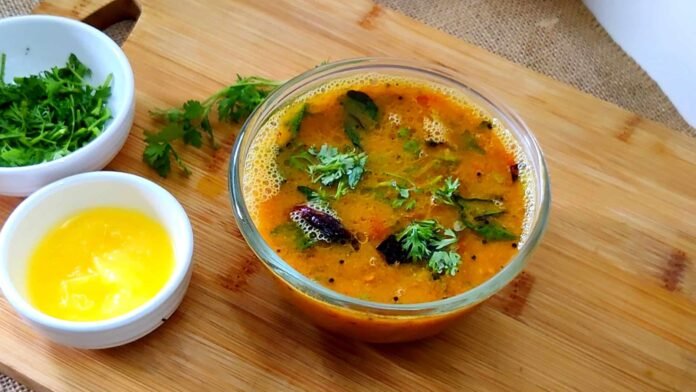
 Support Us
Support Us 


